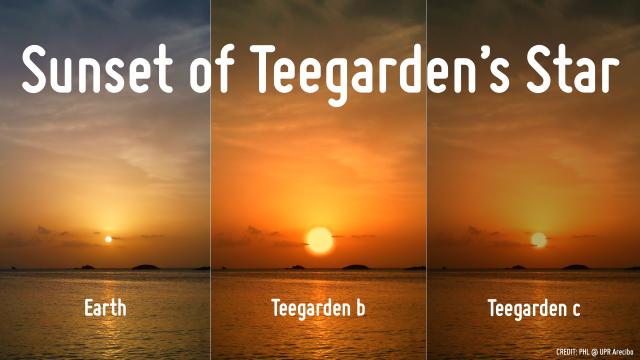Scientists have discovered a pair of temperate, Earth-sized exoplanet candidates around a nearby star, according to a new paper. What makes this planetary system stand out from all the others discovered in recent years is just how similar one of its planets may be to Earth.
Teegarden’s star is a relatively quiet, ultra-cool star, only 12 light-years away. It’s the 24th closest star to the Sun. Researchers observed it as part of the larger CARMENES survey for exoplanets, and found evidence for a pair of planets orbiting the star. Their discovery provides us with more chances to potentially find hints of extraterrestrial life.
“After the first discoveries, now we’re getting the context with these planets,” Guillem Anglada-Escude, astronomer at the Queen Mary University of London, told Gizmodo.
Basically, we’re seeing more of them and can start identifying patterns and figuring out which of these planets are exceptional. “Maybe from some of them we’ll learn specifically about their atmosphere and can start seeing whether any of these terrestrial planets are Earth-like or not.”
CARMENES is a light spectrum-measuring instrument attached to a 3.5-meter telescope at the the Calar Alto Observatory in Spain that searches for the visible light and infrared signals of exoplanets.
As part of this study, it’s surveying “late-type” stars—ones cooler than the Sun. Scientists have already spotted exoplanets in the temperate zones of these kinds of stars, like TRAPPIST-1 and our neighbouring Proxima Centauri.
Teegarden’s star is teeny, at around 9 per cent the mass of the Sun with a temperature of around 2900 Kelvin (2623 Celsius). That’s quite hot compare to Earth, but very cool for a star.
CARMENES detects periodic red and then blue shifts in the light from a star caused by the gravitational pull of orbiting planets. The CARMENES team found evidence of two planets around Teegarden, called Teegarden b and c.
Each has an estimated minimum mass of 1.1 times Earth, and orbit their star every 4.91 and 11.4 days, respectively.
One of these planets, Teegarden b, has the highest Earth Similarity Index of any planet yet discovered, according to the paper published in Astronomy and Astrophysics.
But the researchers immediately offer a caveat: The index doesn’t take into account how the star’s energy is distributed and how the exoplanet’s atmosphere would look as a result, things that would impact the habitability.
Though it might seem like we’ve been finding exoplanets for a while now—the first confirmed discovery was in 1992—we’re still in the early days, Anglada-Escude explained to Gizmodo.
Scientists are just taking a census of these kinds of planets now, so they can later follow up with experiments like the upcoming James Webb Space Telescope and Extremely Large Telescope, which will be able to see these planets in greater detail than current telescopes.
“We are a bit hampered in what we can infer about these planets because we don’t know their radii, but this is a very exciting find, and I hope we will get more observations of this system in the future,” Amy Barr Mlinar, senior scientist at the Planetary Science Institute, told Gizmodo.
Ultimately, it’s going to require patience (maybe a lot of it) before we can truly say we’ve found an Earth-like exoplanet.
Until then, we’ll have to content ourself with learning more about hopeful candidates like Teegarden b and, or course, our imaginations.
